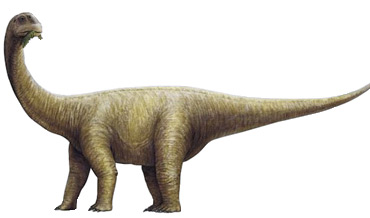
|
Search JoyZine with Google Site Search! |
Rhoetosaurus
Rhoetosaurus (meaning "Rhoetos lizard"), named after Rhoetus, a titan in Greek Mythology, is Queensland’s own Jurassic dinosaur, and was a large herbivore, growing up to 17m long, about 7m high and about 20 tonnes in weight. Rhoetosaurus would have been longer than either Wintonotitan or Diamantinasaurus, titanosaurs from the mid-Cretaceous Winton Formation of Queensland. Rhoetosaurus might have resembled the Late Jurassic Camarasaurus, with a fairly long neck but comparatively short, rigid, tapered tail (not elongated, as in later forms). Rhoetosaurus brownei is one of the largest and most complete Australian dinosaurs known. It is also one of the oldest sauropods, dating from a time when Australia was at high latitudes and closely connected to other Gondwanan continents. The only Australian sauropod older than Cretaceous in age, Rhoetosaurus is a key to understanding the global relationships of early Australian dinosaur faunas. During the Middle Jurassic, south-central Queensland was lushly vegetated, with forests of large araucarian conifers, an understorey of cycads, tree-ferns and lycopods, and a ground cover of smaller ferns and mosses. The climate was wet, humid and subtropical to warm, although the Roma area during the Middle Jurassic was at high latitudes (about 50º south). The remains of Rhoetosaurus were found in what had been a large, sandy plain. Rhoetosaurus, like all sauropods, was probably a browsing herbivore. It may have eaten araucarian conifers, seed ferns and ferns, all known from the Jurassic of Queensland. Rhoetosaurus could have reaching a walking speed of up to 15km per hour (up to 20-30km a day), based on calculations using its limb measurements. Rhoetosaurus had several primitive features and was neither distinctive nor specialized, so it is hard to link it to known sauropod groups. Hollow cavities (pleurocoels) in its bones, however, suggest that Rhoetosaurus had at least some advanced features and that it was more specialized at least in this feature than many Jurassic sauropods. The elongate shape of the neck vertebrae suggests that the neck was relatively long for a sauropod of this period. In 1924, Heber Longman, self-trained paleontologist at (and later director of) the Queensland Museum in Brisbane, learned of a large fossil reptile skeleton exposed at the Durham Downs Station near Roma in central Queensland. The station manager, Arthur Browne, forwarded fragments of bone to Longman, and was honoured with the dinosaur's specific name brownei. The initial collection was of 22 tail vertebrae, including a series of 16 consecutive bones, and other fragmentary hindlimb pieces. Soon after Longman announced the new discovery, he visited the station and arranged for more material of the same skeleton to be sent to the Queensland Museum. These included additional vertebrae from the thoracic area, bits of rib, more caudals and more of the femur and pelvis as well as a cervical vertebra. Rhoetosaurus was first described as a cetiosaurid, Jurassic sauropods basal to Eusauropoda known from both Laurasia and Gondwana. Other suggestions include a possible relationship to Shunosaurus from the Jurassic of China, although this does not seem to be well supported. Although Rhoetosaurus is comparatively complete, the lack of definitive, diagnostic characters makes it difficult to place within a known sauropod group. Many of its characters are primitive (‘plesiomorphic’) and are of little use in determining its relationships. Rhoetosaurus has opisthocoelous dorsal vertebrae with well-developed pleurocoels, which may place it closer to Neosauropoda than to cetiosaurids or basal eusauropods. Rhoetosaurus, originally described in 1926 before the development of modern systematics, is currently the subject of a long-overdue revision. |
